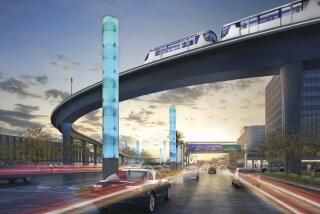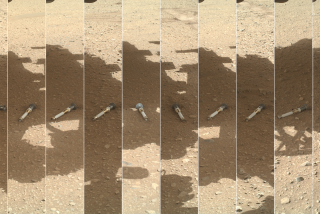House Votes to Continue Space Station : Congress: Backers say vote could represent the program’s last serious congressional challenge.
WASHINGTON — Turning back a determined effort to ground the planned space station Freedom, the House on Wednesday voted decisively to continue construction of the controversial $30-billion project.
“I think this is a victory for America’s future,” said an ebullient Daniel S. Goldin, the new administrator of the National Aeronautics and Space Administration. “I’m very proud of the Congress of the United States.”
It was the fourth time in the last two years that the House has affirmed its commitment to build the orbiting space laboratory. Supporters said the vote could well represent the program’s last serious congressional challenge.
“We expect this will put the issue behind us,” said Rep. George E. Brown Jr. (D-Colton), chairman of the House Committee on Science, Space and Technology, and a strong supporter of the station.
The House rejected by a 237-181 vote an amendment proposed by Rep. Bob Traxler (D-Mich.) that would have cut nearly all of the $1.725 billion set aside for the station in NASA’s budget for the 1993 fiscal year, which begins Oct. 1.
The vote was watched carefully in Southern California, home to two of the station’s three prime contractors--McDonnell Douglas Space Systems Co. of Huntington Beach, and the Rocketdyne Division of Rockwell International in Canoga Park. Together, the companies hold contracts worth $5 billion.
Support was bipartisan as 110 Democrats joined 127 Republicans to save the Bush Administration’s premier manned space project.
Even so, the money set aside by the House is $525 million short of what the Administration requested, nearly $300 million less than the amount appropriated last year.
Supporters said they will seek to boost space station funding when the Senate considers NASA funding later this summer. The Senate Appropriations Committee, which has consistently supported space station funding, could take up the bill as soon as today.
First proposed in 1984 at an estimated cost of $8.3 billion, space station Freedom is the centerpiece of NASA’s manned space program reaching into the early 21st Century.
It is intended to serve as a research facility to study the long-term effects of space on humans, in preparation for possible manned missions back to the moon and to Mars in the next century. In addition, NASA has said that biomedical and microgravity research aboard the station could have important spinoffs on Earth, in the form of new products and medical advances.
But opponents of the project argued Wednesday that it is a scientific humbug that the nation can ill afford in tough economic times.
“People in our cities can’t afford to look upward to the heavens when they’re having a hard time here on Earth making ends meet,” said Rep. Thomas M. Foglietta (D-Pa.).
Critics referred to the station as “flying pork” and “the most expensive government housing project in history.”
Others cited the opposition of some scientific organizations that contend that the station has been so stripped down, in order to save money, that it will not be able to support significant research.
Supporters said the nation needs the station to ensure America’s continued leadership in manned space exploration, to save 75,000 high-tech jobs directly and indirectly associated with the project, and to assist the American aerospace industry as the threat of the Cold War recedes into history.
“Our future lies beyond some new horizon that we have not dreamed of yet,” said Rep. Jerry Lewis (R-Redlands).
“We can’t afford not to build it,” said Rep. Jim Bacchus (D-Fla.). “We can’t afford to relinquish a generation of American leadership in space.”
The space station is planned as a pair of living and laboratory modules suspended from a 353-foot long aluminum truss, powered by three sets of giant solar panels.
The first components are to be launched aboard a space shuttle in November, 1995.
The station is to be ready for a permanent, four-person crew by the year 2000. It has a projected life span of 30 years.
More to Read
Get the L.A. Times Politics newsletter
Deeply reported insights into legislation, politics and policy from Sacramento, Washington and beyond. In your inbox three times per week.
You may occasionally receive promotional content from the Los Angeles Times.










